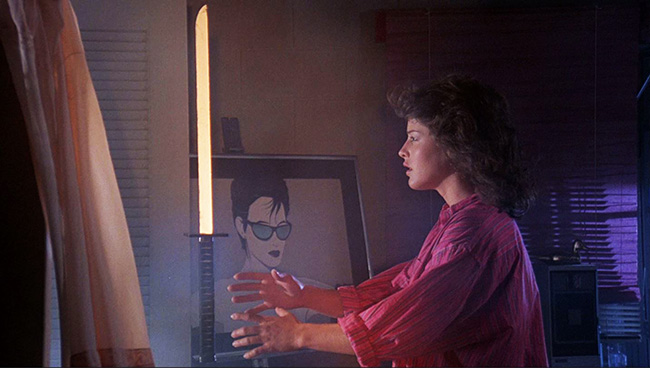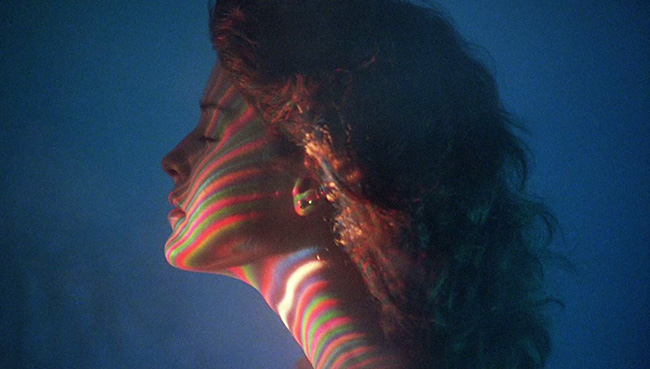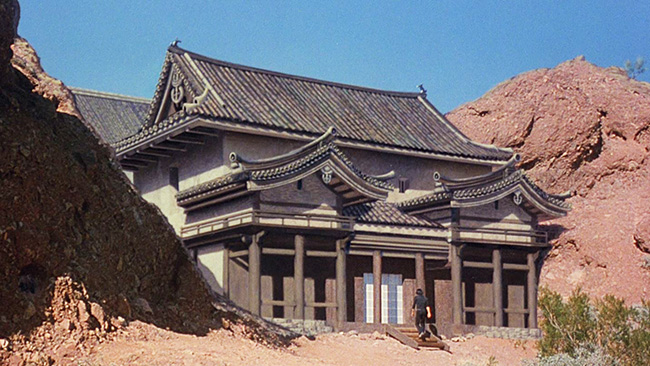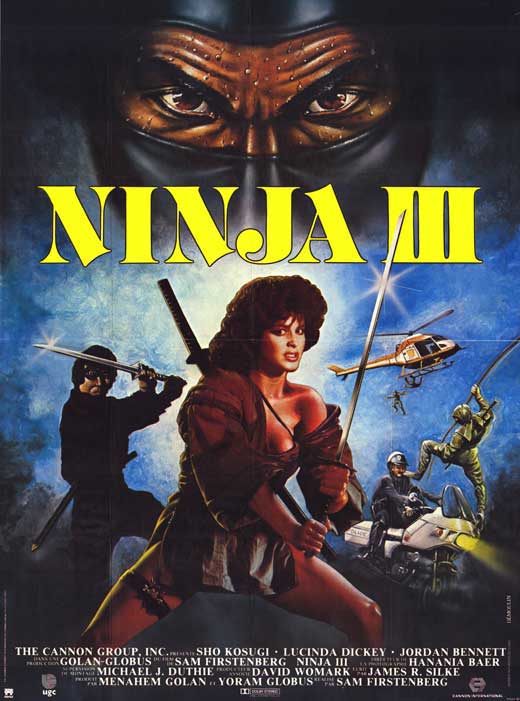
In the nostalgic Stranger Things rush to paint the 80’s as the era of Steven Spielberg, John Carpenter, and John Hughes, it’s easy to forget what the pop culture of that decade was really all about: ninjas. So many, many ninjas. Kids in school made throwing stars out of paper, since the real things were illegal and unobtainable, and in their off-hours ran around in pajamas and hoodies with their mothers’ black scarves tied over their mouths, somersaulting and striking ninja poses. Comic book superheroes fought ninjas on rooftops, Toys ‘R’ Us pushed safety-approved ninja toys, kids played as ninjas in video games like Ninja, The Last Ninja, Shinobi, and Ninja Gaiden, and in the drive-ins we got movies like Enter the Ninja (1981), Revenge of the Ninja (1983), American Ninja (1985), Pray for Death (1985), Gymkata (1985), and Ninja Terminator (1985), among many others. If there was one actor whose name was synonymous with Ninja, it was Shô Kosugi. Kosugi was a Karate Champion who also practiced Judo, Ninjutsu, and other martial arts. One of his earliest film roles was in the perfectly-titled Brucesploitation movie Bruce Lee Fights Back from the Grave (1976), before he made his formal debut in Enter the Ninja, co-starring with Franco Nero and Susan George. The film was directed by Menahem Golan for Golan-Globus/Cannon Group, and bore all the trademarks of the house style: deliriously stupid action, gratuitous violence, and atrocious dialogue. The film was a hit, and the company was quick to exploit Kosugi and the ninja brand in general. After Revenge of the Ninja, the series reached its inarguable apex with Ninja III: The Domination (1984), which borrowed liberally from The Exorcist because…why not?

A ninja (David Chung) goes on a rampage at a golf course.
Confusing enough that the film is called Ninja III, as though it were a sequel to movies called Ninja and Ninja II. It’s actually shorthand for the non sequitur approach which the film will take from one scene to the next. We open on a black-clad ninja (David Chung) who enters a conspicuously massive cave in the Arizona desert (which appears to be about a half-mile from the city outskirts). He opens an ancient weapons chest with LED lighting and arms himself with his ninjatō sword and shuriken throwing stars. Then he steals into a golf course and begins slaughtering everyone in sight. Not even a couple fleeing at 5 MPH in a golf cart is safe. Cops in cars and on motorcycles race to the scene, but he executes them one by one. A police helicopter swoops in, but he climbs a palm tree, leaps onto the chopper, and takes out its pilot with a shuriken tossed from his shoe. At long last the tide begins to turn against him, police riddling his body with bullets (shooting him while standing in a circle, because they really trust their aim). The ninja somehow escapes again, and finds a utility worker, Christie (Lucinda Dickey of Breakin’ and Breakin’ 2: Electric Boogaloo), passing her his sword as well as his soul. She calls the cops, but keeps the sword hidden (somehow). At the station, officer Billy (Jordan Bennett) asks her out, but she can’t get over her hatred of cops. Soon after, she breaks up a broad-daylight rape attempt by beating up the thugs using martial arts passed to her by the spirit of the evil ninja. Billy threatens to arrest her for assault, but it’s just another attempt to score a date. Her resistance pushes him to a breaking point: “You know, I am sick and tired about hearing how you don’t like cops. Cuz I want to tell you something Miss Independence. I like being a cop. And if you don’t want to go out with me because I’m a cop, then to hell with you, lady!” This speech wins her over, and she seduces him in her apartment by pouring a can of V-8 down her neck and letting him lick it off.

Christie (Lucinda Dickey), under the influence of a dead ninja, is laser-scanned by an arcade game. I’m sorry, I don’t know what I just wrote either.
Christie’s apartment is a wonder of decor and style, bringing together: a rooftop vent fan sitting on top of a refrigerator, the stand-up arcade game Bouncer, a piece of art in the style of Duran Duran’s Rio album cover sitting on a canvas stand, a payphone, a dummy with a trenchcoat and a motorcycle helmet, a sousaphone mounted on the wall, a marionette, neon squiggles, and lots and lots of plants. But at night, this apartment becomes sinister. The closet doors open, dry ice fog pours out, and a portal to Hell opens up just behind a shelf of towels. Her arcade machine lights up and scans her face with lasers like it’s about to teleport her to the world of Tron, or perhaps into a-ha’s “Take Me On” video. When she’s not practicing aerobics or climbing telephone poles (she’s a Flashdance-worthy Renaissance woman), she goes out to murder those cops who shot down the ninja that now possesses her. One of these victims is a middle-aged man about to have a three-way in a health spa’s jacuzzi. When the possessed Christie steps half-naked into the tub to join them, just before the killings start, one of the girls declares, “What the hell kind of a place is this?” – because it’s not like she’s down for anything sleazy. Concerned with all the murdering, Christie and Billy go to see the Japanese spiritualist Miyashima, played by the ubiquitous James Hong (Big Trouble in Little China, Blade Runner). He exposes the evil ninja spirit after putting Christie in chains, which fail to stop her from doing acrobatic backflips during the ceremony. Miyashima explains that only a ninja can destroy a ninja, which is not true, but for the purposes of this film, fine. Enter Yamada (Shô Kosugi), whose eternal enemy is the Black Ninja that now resides in Christie.

A desert shrine is the setting for the final confrontation.
Kosugi has thus taken a back seat to the true star of the film, dancer and Cannon star Lucinda Dickey, but in Dickey’s fight scenes it’s clear that her dancing background hasn’t served her as well as it did for, say, Sandahl Bergman in Conan the Barbarian. She goes through the motions, but lightly touches her enemies, as though playing a game of tag – it’s the kind of pretend ninja game that I used to play as an 80’s kid. Kosugi of course fares much better, and the one interesting fight in the film takes place in a derelict home where he and his ninja opponent crash through the floors, from one level to the next. The finale takes place in a temple in the Arizona desert, culminating in a ledge-dangling showdown with the evil ninja (now in his own corporeal form again) – where the villain drops to his death in a fall that looks to be about five or six feet. The synthesizer-drenched Ninja III: The Domination is nonetheless the high point in the series, one in which the barely-disguised absurdities of its predecessors give way to shameless, openly-embraced absurdities. It would equally pair well with standard 80’s action fare, with the tasteless demonic thriller Amityville II: The Possession (1982), or with a crude 80’s ninja computer game – and you can’t say that about very many films.










